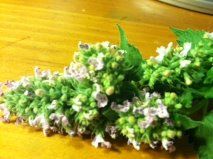 My grandson loves cats, but he struggles to understand that you can’t tell a cat what to do. I have found catnip to be the same way.
My grandson loves cats, but he struggles to understand that you can’t tell a cat what to do. I have found catnip to be the same way.
Last summer my neighbor came by for some catnip for his cat, but the patch I had planted in the parkway, for people’s easy access, was hanging on by its fingertips. While the two self-seeded patches, one under the pawpaw tree and the other three feet tall in full sun, were thriving.
I blamed the failure on the drier conditions of the parkway and as Philip Miller observed in his 1754 Gardener Dictionary, “If you set it, the cat will eat it. If you sew it, the cat won’t know it.” Meaning: if you plant catnip from the seed the neighborhood cats won’t roll in it, but if you plant a plant they will.
Lesson learned, now I let nature and the catnip decide where it should grow and I get a nice crop.
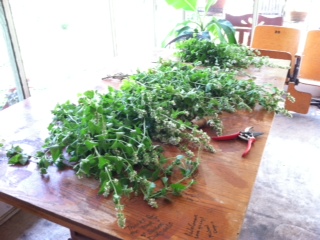
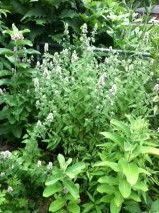
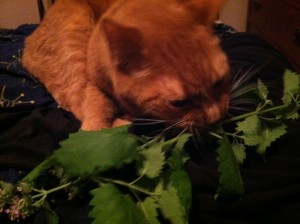
Prior to trade routes to China providing access to black tea, catnip tea was a popular with Europeans. My mind congers up humorous incidences considering catnip’s sleep inducing properties. After my hysterectomy, for the first time in my life I had difficulty sleeping. In desperation I tried the TeePee Dreams Tea, that my friends had given me years before for watching their cat. I drank it for a couple weeks and got back into the pattern of sleep. The TeePee Dreams Tea contained catnip. Another score for catnip!
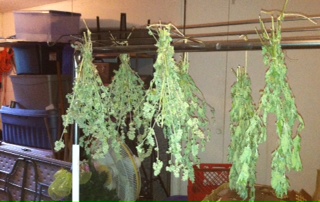
Our local herb society is always kind about listening to the properties of an herb, but really they want to know how to eat it. My dear friend Rose makes a fabulous catnip pesto, which she serves with a little feta on bruschetta!
Catnip tenderizes meat, it can also be added to soups or sauces and my friend Alison makes lovely catnip infused vodka. Some of you of a certain age may remember Euell Gibbons, he reportedly candied the leaves to serve as an after dinner digestive aid. I like the taste of catnip tea, but if you don’t you might try adding lemon balm, which is also a calming herb. To make catnip tea just add the dried leaves and flowers to warm water and cover it to steep. It is best to use water heated to the point just before it reaches boiling. A general ratio is one teaspoon catnip to one cup water.
Catnip has traditionally been used to for its calming affects helping with anxiety, colic, cramping, sleeping and tension headaches. It also softens muscles of the digestive tract so soothes digestion, heartburn and colic. Because it induces sweating it was also used to cool down on hot nights or break a fever. It is important to note that catnip should be avoided by pregnant women because of its history of bringing about menstruation. As John K’Eogh wrote in his General Irish Herbal (1735) about catnip: “It provokes urination and menstruation: it expels the stillborn child; it opens obstructions of the lungs and the womb, and is good for internal bruises and shortness of breath. Drunk with salt and honey, it expels worms from the body.” While in modern times we rarely have issues with internal worms, that is good to know.
Catnip was found to be ten times more effective than DEET as a mosquito repellant by an Iowa State University study. They also found that catnip repeals cockroaches. Traditionally catnip has also been used to repel fleas and rodents.
While the above ground part of the catnip calms and relaxes. According to British folklore the catnip root “when chewed it is said to make the most gentle person fierce and quarrelsome”. Executioners and those going into battle chewed the root. As a menopausal woman I did not think it was wise to check out that aspect of catnip~ha!
There was a controversial study published in the 1969 Journal of the American Medical Association, which found that catnip had similar effects as marijuana when smoked. The controversy was that the plant pictured was marijuana not catnip. Following the Wise Woman tradition of studying all aspects of a plant I convinced my buddy, who is not terribly discerning about what he smokes, to roll some dried catnip, that I had grown, and smoke it. He brought it to poker night to have witnesses in case things went badly. After a couple puffs his poker buddies made him put it out because the smell was so repulsive.
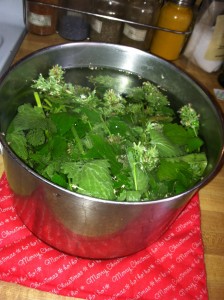
My wool spinning friend told me that catnip is used as a natural light yellow dye not only for wool, but also for hair. In the Wise Woman tradition I experimented with the catnip as an herbal hair dye, treatment for split ends and clarifier. I added catnip to water heated just prior to boil. Turned off the heat and let it steep with the lid on for five hours. I strained out the catnip, coated my hair with the catnip tea then put on a plastic shower cap for one hour. I didn’t notice a change in color, but my hair was really soft. I think it would work better on people with light colored hair. For a love potion follow the same process, but add a dash of cinnamon then sprinkle it on your doorstep for 21 days. Love potions are tricky business, so do some research first. I used it and met my ex-fiancé the next month, but as you can note from the “ex” before fiancé, it didn’t hold.
Well, that is what I have learned on my Wise Woman discovery of catnip! Now you can see how this skunky perennial has held my and the world’s interest for so long! Standard herbal disclaimer: this is for informational purposes and not meant as medical advice.


